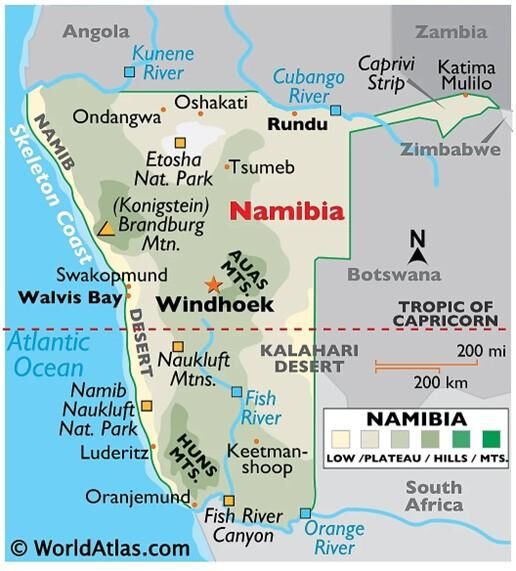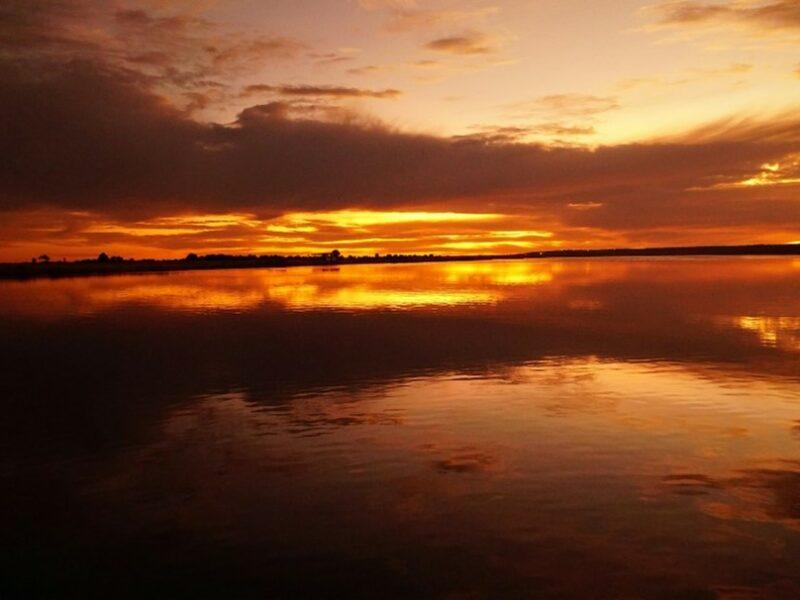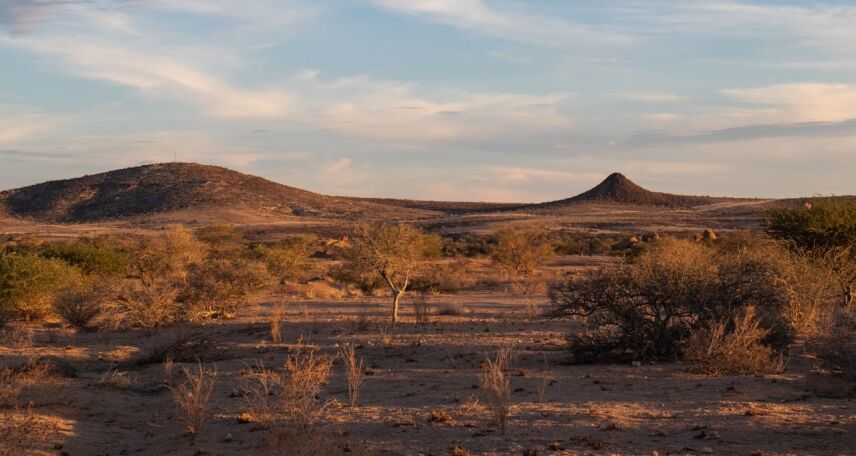Situated on Africa’s west coast, Namibia’s popularity as both an African plains game, and dangerous game hunting destination continues to grow. Offering hunters a wide array of wildlife species to target in this land of contrasts, Namibia has proven time and again its success as a premier hunting destination, with exceptional trophies and game hunting experiences. You honestly cannot go wrong with plains game hunting in Namibia.
[DYNAMIC-BLOGTABLEOFCONTENT]
Why Choose to go Hunting in Namibia?
- Namibia offers game hunting enthusiasts a wide range of animal species, including African plains game, specialty game, and the ever-notorious members of the Big 5 and Dangerous 7.
- Namibia is the only country worldwide where all Big 5 and Dangerous 7 members can be hunted. These include the lion, leopard, elephant, rhino, Cape buffalo, Nile crocodile, and hippo.
- Namibia challenges hunters with a diverse array of landscapes and conditions in which to hunt: From the arid regions of the desert to the lush Zambezi region (formerly the Caprivi Strip), this African destination allows hunters to push and challenge themselves not only in terms of prey targeted but also in testing conditions and hunting regions.
- Easy access to the country from Europe and although there aren’t any direct flights between Namibia and the US, many US-based airlines do offer flights into Johannesburg or Cape Town, which is a quick-stopover to reaching Namibia.
- Expect value for money in terms of game hunting safaris.
- Both bow hunting and rifle hunting in Namibia is allowed.
- The landscape and types of wildlife allow for a variety of hunting methods including bait and blinds, spot and stalk as well as walk and stalk options.
- Namibia has a long hunting season and offers hunting from the beginning of February to the end of November, allowing hunters to easily plan and book great hunting safaris in Namibia, at a time that suits them.
- For those enjoying dangerous game hunting, Namibia is also the only destination where cheetahs can be legally hunted.

Where can l enjoy Hunting in Namibia?
Game hunting in Namibia is conducted on government hunting concessions or privately owned properties.
Private hunting safari options leave a hunter spoilt for choice, with ranches ranging from several thousand acres to millions of acres, with access to big game, dangerous game, and African plains game species.
These hunting ranches are spread all over Namibia, showcasing the best of what Namibia has to offer.
Government concessions for safari hunting take place mainly in the North of the country.
Popular Hunting Areas in Namibia
Namibia’s hunting regions can be divided into five sections or regions, each offering hunters a different challenge:
Zambezi Region (previously known as the Caprivi Strip)
Situated in Namibia’s northeastern region and sharing a border with Botswana, Angola, and Zambia, this area features forests, rivers, and savannas. It is home to a range of wildlife, including dangerous game such as hippos, elephants, leopards, and Nile crocodiles.
Kunene (North-West)
This area stretches from the Skeleton Coast to the Kunene Delta and is home to the most majestic of creatures, the revered desert-adapted elephants, as well as numerous African plains game species.
Otjozondjupa (Waterberg, Otjiwarongo & Okahandja)
This area is known as the Waterberg plateau and offers hunters a challenge in terms of differing landscapes and terrains, such as valleys and forest-type regions. It is home to numerous African plains game species, including the Cape eland, oryx, and greater kudu.
Khomas Highlands
Close the the nation’s capital, Windhoek, lies the Khomas highlands that are home to the elusive leopard if you are looking for a dangerous game hunting experience, as well as kudu, Hartmann’s zebra, and gemsbok (oryx).
Erongo (Damaraland)
This area is home to numerous species, including kudu, wildebeest (black and blue), and warthog, amongst others.
A reminder that hunting in Namibia only takes place during the day and night time hunting is not permitted, as well as hunting with lights.

What is African Plains Game?
African plains game refers to the large and diverse groups of antelopes and other animals found inhabiting sub-Saharan Africa. They do not include members of the Big 5 or Dangerous 7, but antelopes and animals that inhabit the savannas and plains of the region.
While many people think it only includes larger species such as the wildebeest, or kudu, African plains game also includes smaller antelope species such as the endemic Damara dik-dik, and numerous types of duikers, as well as species such as giraffe, wildebeest, and warthogs.
Plains game hunting in Namibia is an exciting and adventurous game hunting safari, where the hunter can experience the most beautiful and diverse landscapes while enjoying varied African plains game species, from small to large, on their hunting safari.
What African Plains Game Species are found in Namibia?
Namibia is home to more than 20 species of African plains game, including amongst others:
- Eland
- Greater Kudu
- Damara Dik-Dik
- Black-faced Impala
- Springbok
- Oryx (gemsbok)
- Warthog
- Giraffe
- Hartmann’s zebra
- Burchell’s Zebra
- Blue Wildebeest
- Red Hartebeest
- Steenbok
- Black Wildebeest
- Lechwe
- Waterbuck
- Sable
- Blesbok
- Common Duiker
Let’s look at some of the iconic species:
Common Eland
The common eland (Taurotragus oryx) is also known as the Cape eland and is found throughout sub-Saharan Africa. It is the second largest antelope in Africa, second only to the Greater eland. These herbivores are renowned for their large size, jumping ability, as well as their spiral-shaped horns.
Damara Dik-Dik
From one of the largest antelopes in Namibia to one of the smallest, namely the endemic Damara Dik-Dik (Madoqua kirkii). This shy and elusive antelope, referred to as a pigmy antelope due to its size, has perfected the art of camouflage and hiding and is only found in the Kunene region of Namibia. Damara dik-dik hunting in Namibia requires the utmost stealth, patience, and expert shot placement for this member of the Tiny 10.
Oryx
The oryx (Oryx gazella), also known as a gemsbok in South Africa, is a beautiful, graceful antelope with a set of striking, spear-like horns that make it a popular trophy for African game hunting enthusiasts. Endemic to Namibia and other Southern African countries, this iconic antelope is best targeted in the drier region of the Kalahari and is often targeted for both its horns and meat.
Springbok
A medium-sized antelope, the Springbok (Antidorcas marsupialis) reaches weights of just over 90 pounds. Best hunted in the northwestern area of Namibia, this graceful antelope remains a sought-after African plains game target.
Warthog
Ask any hunter who has had the pleasure of hunting these hogs, they truly are fun to hunt! They are wiry, and fast, and allow an action-packed hunting adventure for any game hunting enthusiast. Warthogs (Phacochoerus africanus) are best hunted in the early morning or late afternoon.
Black-faced Impala
The black-faced impala (Aepyceros melampus petersi) is endemic to Namibia and is found in the northwestern region of the country. They differ from the common impala by being slightly larger, darker in color, and have a black marking running in the center of their face.
Gray Duiker
The gray duiker (Moschus grimmia), also referred to as the common duiker or the bush duiker, is a small to medium-sized antelope that is often targeted in the Khomas region of the country. They are the largest of the duiker species and are skittish, excellent at camouflage, and make a challenging, yet very rewarding target when game hunting in Namibia.
Waterbuck
Sticking to habitats close to water, the waterbuck (Kobus ellipsiprymnus) sticks to the central and northern regions of Namibia. A shaggy, medium to large antelope, the waterbuck makes for an exciting stalking game hunting safari.
Giraffe
A rather larger African plains game target, the giraffe (Giraffa) is a challenging species to target when hunting in Namibia. It requires the hunter to always be on their A-game, as one kick from this large mammal could end the hunting safari – permanently. The country’s Kunene region is a popular game hunting destination.
Greater Kudu
No African hunting safari is complete without this majestic beast! This iconic species is renowned for its beautiful spiral horns, along with its striking coat. The Greater kudu (Tragelaphus strepsiceros) is hunted throughout most of the country, but the best hunting experiences can be enjoyed in the Erongo area.
Which Caliber is best for African Plains Game Hunting in Namibia?
The .270 is a good option for plains game hunting, although larger targets such as the kudu and eland would better be served with a .30-06 Springfield with heavier bullets. This should work well to ethically and humanely target most African plains game targets while enjoying hunting safaris in Namibia.
Shot Placement on African Plains Game Species
Like with anything in life, when you do it, do it properly. And nothing is truer than when it comes to shot placement during an African hunt. To ensure ethical and humane hunting, shot placement remains of critical importance while on your Namibia plains game hunting safari.
Ensure that you are well-versed in shot placement of the African plains game you are planning on targeting. Check out our section on shot placement for African plains game for further information, tips, and techniques that may stand you in good stead to secure your dream game hunting trophy.
How Does Hunting in Namibia Contribute to Conversation Practices?
Hunting in Namibia does, in fact, contribute greatly to conservation initiatives. The Namibian government’s approach to hunting is refreshing and sees the value that game hunting plays in conservation. They focus on conservation hunting, community involvement, as well as sustainable hunting practices.
As Uahekua Herunga, Minister of Environment and Tourism of Namibia, commented, “ We see hunting as an integral part of our conservation strategy and the broader economy… Without hunting, wildlife will not remain a viable form of land use in rural Namibia and may be replaced by other forms of land uses more damaging to our ecosystems.” (Source: www.conservationsource.org)
- Namibian hunting safaris generate revenue for both local communities and landowners and provide an income to support conservation efforts in the region.
- By allowing hunting in Namibia, species and animal populations are correctly managed. For example, animals that are older and past their breeding age may be targeted for game hunting in Namibia, or perhaps, in the case of an elephant herd, an individual that is causing trouble within the herd or surrounding environment.
- By providing incentives for contributing to conservation, local communities as well as landowners are then motivated to ensure that they protect the wildlife and their habitats, which are needed for hunting, and then in turn the hunting will provide financial benefits for them.
- By allowing communities to become involved in the decision-making processes of hunting quotas, as well as conservation initiatives and programs, people feel involved and will be more willing to adhere to and participate in conservation strategies.
- Hunting safaris in Namibia generate revenue, and this revenue is allocated where needed, including anti-poaching efforts, habitat protection, as well as wildlife monitoring.
Namibia: A Hunter-Friendly Environment
One of the great aspects of hunting in Namibia, apart from the diverse array of wildlife and therefore different game hunting options available, is the hunting-friendly environment that is supported by both the government and local inhabitants. Provided that the hunting regulations are adhered to, the government supports extensive hunting in Namibia, with ethical and sustainable practices providing the backdrop for a very successful game hunting destination. For locals, hunting safaris are not only a way of life for them but also allow them to provide for their families uniquely and sustainably.
Namibia remains a destination that has taken hunting and conservation by the hand and led them into the future, together, to make a difference, to empower and create a safe hunting model where conservation principles and efforts remain the key ingredients to a happier, sustainable wildlife population for future generations to come.
If you enjoyed learning about African plains game hunting in Namibia, learn more about hunting the world’s fastest land animal, the cheetah (Chasing Spots: Cheetah Hunting in Namibia), or discover the fascinating world of Big Game Hunting in Namibia.
